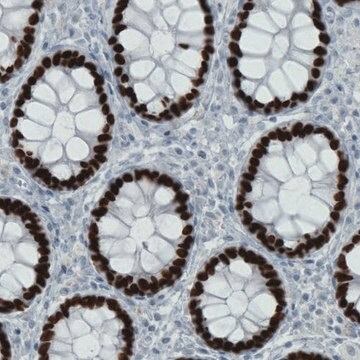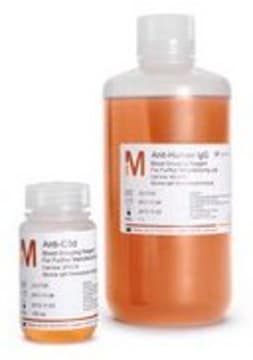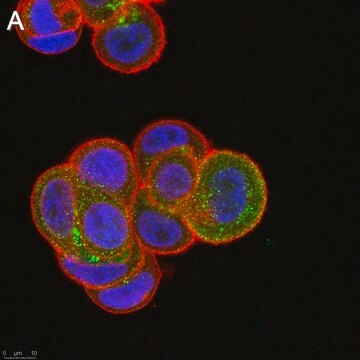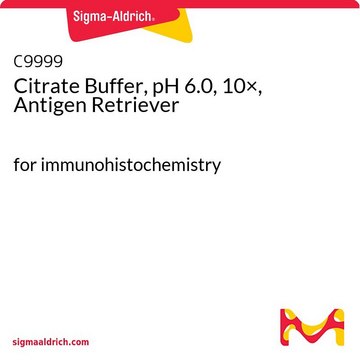General description
We are committed to bringing you greener alternative products, which adhere to one or more of The 12 Principles of Green Chemistry.This antibody is Preservative-free, produced without the harm or sacrifice of animals and exceptionally stable to allow for ambient shipping and storage if needed and thus aligns with "Waste Prevention", "Designing Safer Chemicals" and "Design for Energy Efficiency".
Click here for more information.
ZooMAb® antibodies represent an entirely new generation of recombinant monoclonal antibodies. Each ZooMAb® antibody is manufactured using our proprietary recombinant expression system, purified to homogeneity, and precisely dispensed to produce robust and highly reproducible lot-to-lot consistency. Only top-performing clones are released for use by researchers. Each antibody is validated for high specificity and affinity across multiple applications, including its most commonly used application. ZooMAb® antibodies are reliably available and ready to ship when you need them.
Specificity
Clone 1E16 is a ZooMAb® rabbit recombinant monoclonal antibody that specifically detects MAP kinase-activated protein kinase 2 (MAPKAPK-2). It targets an epitope within 17 amino acids from the C-terminal region.
Immunogen
KLH-conjugated linear peptide corresponding to 17 amino acids from the C-terminal region of human MAP kinase-activated protein kinase 2 (MAPKAPK-2).
Application
Quality Control Testing
Evaluated by Western Blotting in NIH3T3 cell lysate.
Western Blotting Analysis: A 1:10,000 dilution of this antibody detected MAPKAPK-2 in NIH3T3 cell lysate.
Tested Applications
Western Blotting Analysis: A 1:1,000 dilution from a representative lot detected MAPKAPK-2 in MCF-7 and COS-1 cell lysates.
Immunohistochemistry (Paraffin) Analysis: A 1:100 dilution from a representative lot detected MAPKAPK-2 in Human stomach tissue sections.
Affinity Binding Assay: A representative lot of this antibody bound MAPKAPK-2 peptide with a KD of 1.5 x 10-7 in an affinity binding assay.
Immunocytochemistry Analysis: A 1:1,000 dilution from a representative lot detected MAPKAPK-2 in MCF-7 cells.
Note: Actual optimal working dilutions must be determined by end user as specimens, and experimental conditions may vary with the end user.
Target description
MAP kinase-activated protein kinase 2 (UniProt: P49137; also known as EC:2.7.11.1, MAPK-activated protein kinase 2, MAPKAP kinase 2, MAPKAP-K2, MAPKAPK-2, MK-2, MK2) is encoded by the MAPKAPK2 gene (Gene ID: 9261) in human. MAPKAPK-2 is a stress-activated serine/threonine protein kinase that is ubiquitously expressed and is involved in various cellular activities, including cytokine production, endocytosis, reorganization of the cytoskeleton, cell migration, cell cycle control, chromatin remodeling, DNA damage response and transcriptional regulation. It is activated following phosphorylation by p38α at threonine 222, serine 272, and threonine 334. Once activated, it phosphorylates serine in the peptide sequence, Hyd-X-R-X2-S, where Hyd is a large hydrophobic residue. Its substrates include a variety of cellular proteins. It is reported to mediate the phosphorylation of HSP27 in response to stress, leading to the dissociation of HSP27 from large small heat-shock protein (sHsps) oligomers and impair their chaperone activities and ability to protect against oxidative stress. MAPKAPK-2 is also involved in inflammatory response by regulating tumor necrosis factor and IL-6 production. It phosphorylates several RNA binding proteins leading to the regulation of the stability and translation of TNF and IL-6 mRNAs. MAPKAPK-2 is detected in cytoplasm as well as in the nucleus. Its phosphorylation and subsequent activation are shown to release the autoinhibitory Helix™ that results in its export from the nucleus into the cytoplasm. It is also involved in late G2/M checkpoint and following DNA damage it relocalizes from nucleus to cytoplasm and phosphorylates HNRNPA0 and PARN, which LEADS™ to stabilization of GADD45A mRNA. This ZooMAb® recombinant monoclonal antibody, generated by our propriety technology, offers significantly enhanced specificity, Affinity™, reproducibility, and stability over conventional monoclonals. (Ref.: Manke, IA., et al. (2005). Mol. Cell. 17(1); 37-48; Coxon, PY., et al. (2003). Cell Signal. 15(11); 993-1001; Ben-Levy, R., et al. (1995). EMBO J. 14(23); 5920-5930).
Physical form
Purified recombinant rabbit monoclonal antibody IgG, lyophilized in PBS with 5% Trehalose, normal appearance a coarse or translucent resin. The PBS/trehalose components in the ZooMAb formulation can have the appearance of a semi-solid (bead like gel) after lyophilization. This is a normal phenomenon. Please follow the recommended reconstitution procedure in the data sheet to dissolve the semi-solid, bead-like, gel-appearing material. The resulting antibody solution is completely stable and functional as proven by full functional testing. Contains no biocide or preservatives, such as azide, or any animal by-products. Larger pack sizes provided as multiples of 25 µL.
Reconstitution
300 µg/mL after reconstitution at 25 µL per vial. Please refer to guidance on suggested starting dilutions and/or titers per application and sample type.
Storage and Stability
Recommend storage of lyophilized product at 2-8°C; Before reconstitution, micro-centrifuge vials briefly to spin down material to bottom of the vial; Reconstitute each vial by adding 25 µL of filtered lab grade water or PBS; Reconstituted antibodies can be stored at 2-8°C, or -20°C for long term storage. Avoid repeated freeze-thaws.
Other Notes
Concentration: Please refer to the Certificate of Analysis for the lot-specific concentration.
Legal Information
Affinity is a trademark of Mine Safety Appliances Co.
Helix is a trademark of Glass Expansion Pty Ltd
LEADS is a trademark of Compugen
ZooMAb is a registered trademark of Merck KGaA, Darmstadt, Germany
Disclaimer
Unless otherwise stated in our catalog or other company documentation accompanying the product(s), our products are intended for research use only and are not to be used for any other purpose, which includes but is not limited to, unauthorized commercial uses, in vitro diagnostic uses, ex vivo or in vivo therapeutic uses or any type of consumption or application to humans or animals.










